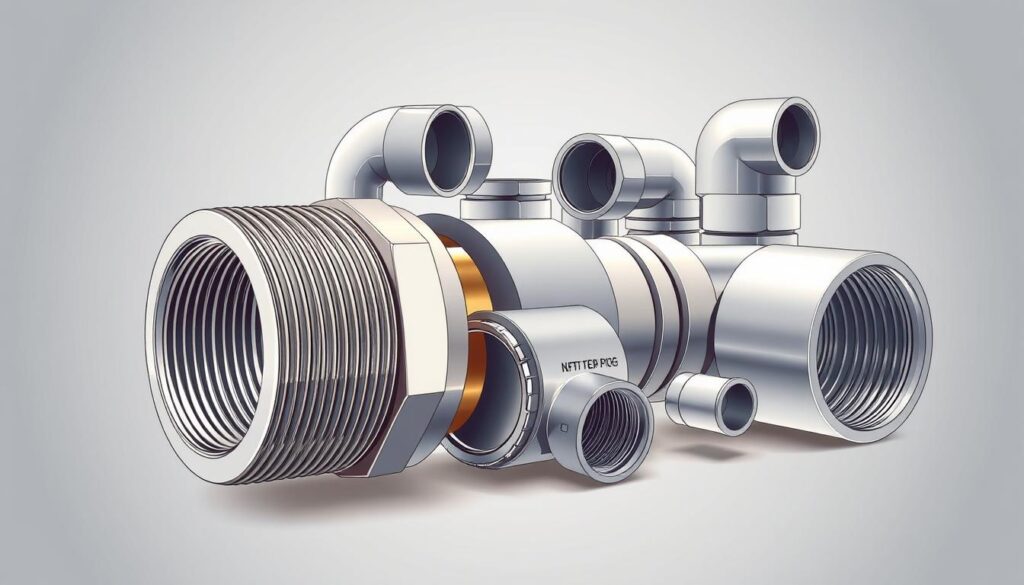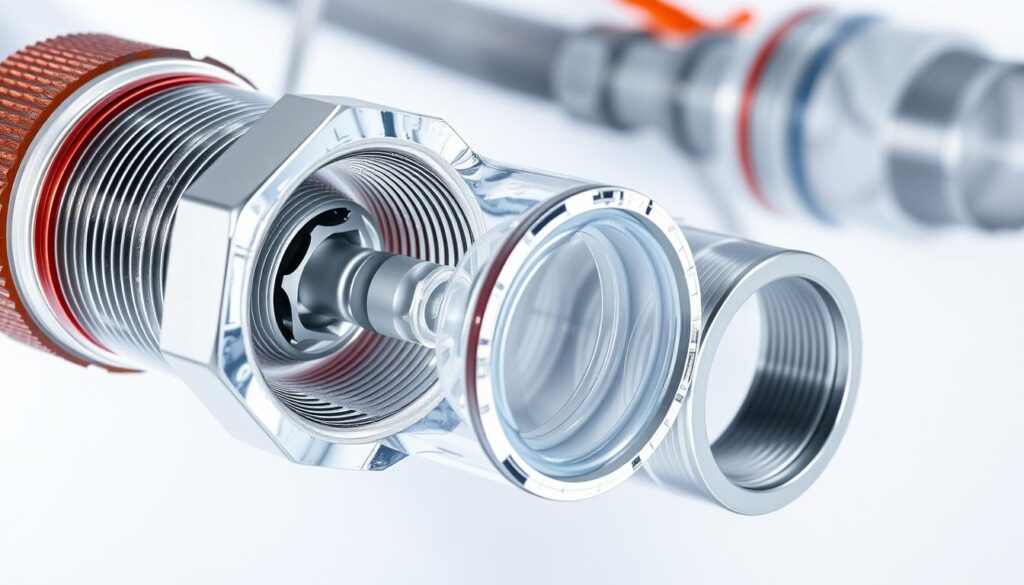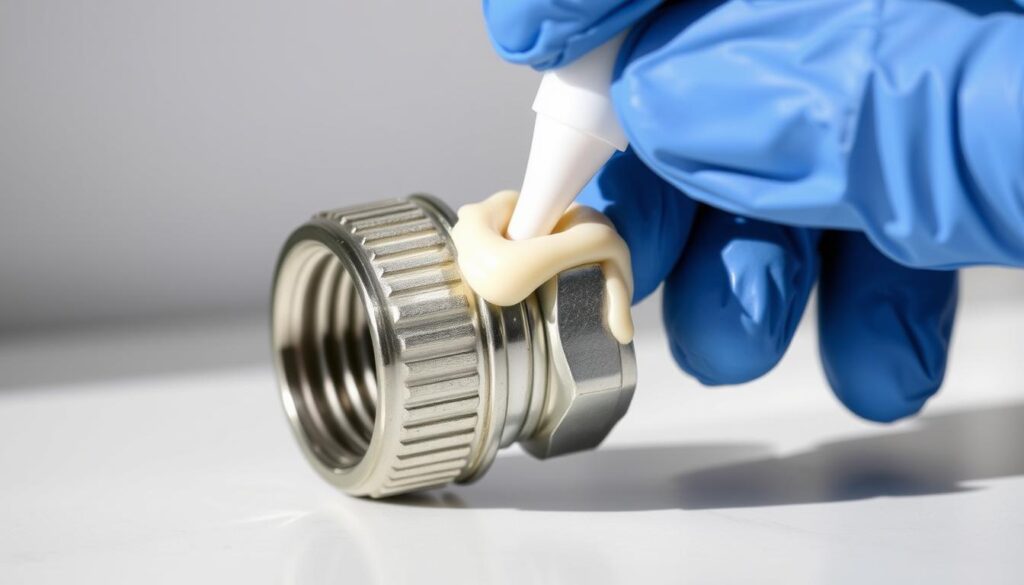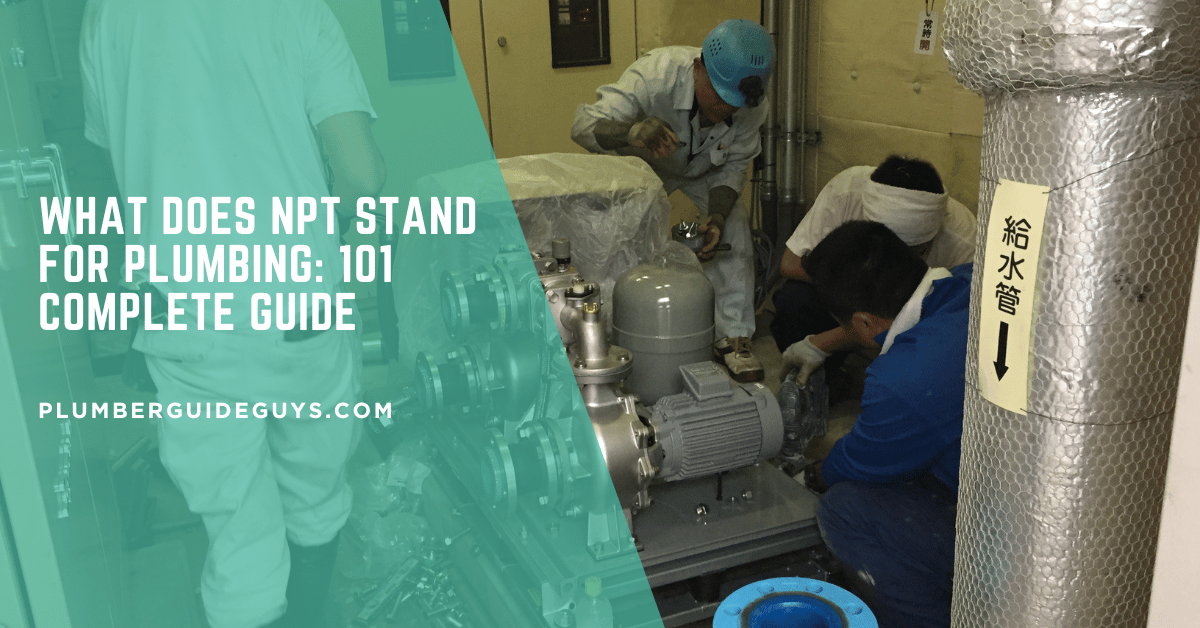Affiliate Disclosure
Plumber Guide Guys is a participant in the Amazon Services LLC Associates Program, an affiliate advertising program designed to provide a means for sites to earn advertising fees by advertising and linking to Amazon.
What Does NPT Stand for Plumbing? Ever wondered how your plumbing stays leak-free and securely connected? The secret is in a key standard called NPT – National Pipe Thread. This guide will explain what NPT means in plumbing and why it’s so important for all pipe connections.

NPT is a standardized threading system that makes sure connections are tight and reliable. It’s used in both home and industrial plumbing. Knowing about national pipe thread plumbing can help you avoid expensive leaks and mistakes when installing.
NPT threads are vital for creating strong, sealed connections in water supply lines and industrial pipelines. They handle high pressures and different environments well. Let’s explore the importance of NPT in today’s plumbing systems.
Key Takeaways
- NPT stands for National Pipe Tapered thread standard
- Provides leak-proof connections in plumbing systems
- Used across residential and industrial applications
- Ensures consistent and reliable pipe connections
- Critical for maintaining structural integrity in piping
Table of Contents
Understanding NPT in Plumbing Systems
NPT threads are key in plumbing and piping systems. They ensure reliable connections in many uses. These threads are vital for secure and leak-free connections in homes and industries.
The meaning of NPT threads is more than just connecting pipes. It’s about a standard way to join pipes and fittings with precision. Knowing about these threads is important for both pros and DIY fans in plumbing.
Definition and Basic Principles
NPT (National Pipe Taper) threads have a special tapered design. This design helps make a tight seal. The main features are:
- Tapered angle of 1°47′ from the center axis
- Self-sealing mechanism through thread compression
- Standardized thread profile for consistent performance
Historical Development of NPT Standards
The history of NPT threads started in the late 19th century. Back then, standardizing pipe connections was key. The early work aimed to create a universal threading system that:
- Ensured reliable sealing
- Provided consistent thread dimensions
- Supported various industrial applications
Importance in Modern Plumbing
NPT threads are essential in today’s plumbing. They offer superior sealing capabilities and are used in many places. From home water systems to industrial machinery, they are vital. Their ability to make tight, leak-resistant connections is priceless in important projects and precise engineering.
Precision in thread design translates to reliability in fluid transfer systems.
Technical Specifications of NPT Threads
Knowing about NPT thread specs is key for making sure connections work right in plumbing and industry. NPT (National Pipe Taper) threads are special because they help make tight and leak-free connections.
The npt thread specs cover important details that experts need to know:
- Thread Angle: 60-degree included angle
- Taper: Made for better sealing
- Measurement: Standard in inches
Looking at an NPT thread size chart, you’ll see different sizes that affect how well they work. The pitch and major/minor diameters are key for strong connections.
Getting NPT threading right is very important. Manufacturers must follow strict rules to make sure connections seal well and are strong. The design of the thread helps it fit together tightly, either by itself or with the help of sealants.
| NPT Size | Major Diameter | Pitch |
|---|---|---|
| 1/8″ | 0.405″ | 27 TPI |
| 1/4″ | 0.540″ | 18 TPI |
| 1/2″ | 0.840″ | 14 TPI |
Understanding these specs helps you pick and use NPT threaded connections correctly in many places.
What Does NPT Stand for Plumbing: Core Components
NPT threads are key in plumbing, making connections secure and reliable. Knowing about these threads helps both pros and DIY folks. It ensures the right installation and performance in many uses.
Thread Design and Angles
NPT threads have a special design that makes them stand out. They have a tapered shape that seals well when installed right. The standard NPT thread specs are:
- A 60-degree thread angle
- A gradual taper of about 1/16 inch per foot
- Right-hand thread direction
Sealing Mechanisms
When it comes to sealing, NPT threads use their tapered design. Tightening the threads compresses the surfaces, making a tight seal.
To make the seal even better, plumbers use extra methods:
- PTFE (Teflon) tape
- Pipe dope or thread sealant
- Thread sealant compounds
Size Standards and Measurements
NPT threads come in sizes from 1/8 inch to 4 inches. These sizes are key for fitting right in plumbing systems. Getting the size right prevents leaks and keeps systems working well.
Choosing the right NPT thread size depends on your plumbing needs, the job, and the connection type.
NPT vs Other Thread Standards
Exploring pipe thread types is key for plumbing pros and DIY fans. The NPT vs BSP plumbing world shows interesting thread designs and uses.
NPT threads are different from BSP threads, a global standard. These differences affect how pipes connect and seal in various settings.
- NPT threads feature a 60-degree angle
- BSP threads utilize a 55-degree angle
- Geographical usage varies by region
Knowing the differences between these threads helps you pick the right connections for your plumbing projects.
| Thread Standard | Thread Angle | Primary Region | Typical Application |
|---|---|---|---|
| NPT | 60 degrees | North America | Residential/Industrial Plumbing |
| BSP (Parallel) | 55 degrees | Europe/Asia | General Piping Systems |
| BSP (Tapered) | 55 degrees | International | Specialized Connections |
When working with different pipe systems, pay close attention to thread specs. Mismatched threads can lead to improper sealing and system failures.
Materials and Manufacturing of NPT Fittings
Creating reliable plumbing connections depends on NPT fittings’ materials and how they’re made. Knowing about these can help you choose the right parts for your needs.
NPT fittings are made from different materials, each with its own strengths. The material you choose affects how well the fittings work, last, and fit together.
Common Material Types
- Brass: Excellent corrosion resistance and durability
- Stainless Steel: Superior strength and chemical resistance
- Carbon Steel: High-pressure applications
- Plastic: Lightweight and cost-effective solutions
Manufacturing Processes
Making NPT fittings requires careful engineering. Different methods are used to ensure the threads fit right and the fittings are strong:
- Cold forming
- Machining
- Casting
- Forging
Quality Control Standards
“Precision in manufacturing determines the reliability of plumbing connections.” – Industrial Engineering Quarterly
Quality checks for NPT fittings are strict. They include tests like checking size, pressure, and material. These steps make sure each fitting meets high standards.
Learning about materials and making processes helps you pick the best NPT fittings for your plumbing needs.
Applications in Residential Plumbing

National pipe thread (NPT) plumbing is key in your home’s water and gas systems. These threads help make connections secure and leak-free. Knowing what npt thread meaning is can show you how vital they are in plumbing.
In homes, NPT threads are used in many important places:
- Water supply lines connecting pipes and fixtures
- Gas distribution systems
- Faucet and showerhead installations
- Water heater connections
- Irrigation system interfaces
The tapered design of NPT threads makes a tight seal. This keeps your plumbing system tight and efficient. With the right sealants like PTFE tape, these threads ensure a leak-free connection.
Professional plumbers trust NPT threads for their durability and consistent performance in homes.
Your home’s plumbing system needs precise connections. National pipe thread plumbing gives homeowners a standard, reliable way to connect pipes, valves, and fixtures.
Industrial Uses and Applications
NPT thread specifications are key in many industries. They ensure reliable connections in important sectors. Knowing about these standards helps us see their value in complex settings.
NPT threads are used in more than just plumbing. They are made to handle tough conditions and perform well in hard environments.
Chemical Processing
In chemical plants, NPT threads stand up to corrosive substances well. Their design ensures:
- Leak-proof connections
- Chemical compatibility
- High-pressure tolerance
Oil and Gas Industry
The oil and gas sector counts on NPT threads for pipelines. These threads offer:
- Secure connections in high-pressure systems
- Consistent performance under extreme temperatures
- Reliable sealing mechanisms
Manufacturing Facilities
In manufacturing, plumbing pipe thread standards are vital. They help with complex fluid systems by providing:
- Precision engineering
- Robust material compatibility
- Seamless integration with various equipment
NPT threads are the core of industrial fluid management systems. They make operations safe and efficient across many sectors.
Installation Best Practices
Installing npt male thread and npt female fittings needs precision and attention to detail. Doing it right ensures a tight, leak-free connection. This connection can handle many plumbing challenges.
Before starting, get the right tools and set up your workspace. Keeping it clean is key when working with npt male thread connections.
- Inspect threads for any damage or debris
- Clean threads thoroughly with a wire brush
- Check for proper thread alignment
- Use appropriate thread sealant
Here’s how to connect npt female fittings:
- Start by hand-tightening the components
- Ensure threads are correctly engaged
- Use a wrench for final tightening
- Apply 1-2 additional turns carefully
| Installation Step | Key Considerations |
|---|---|
| Thread Preparation | Remove all dirt and old sealant |
| Sealant Application | Use tape or liquid sealant sparingly |
| Tightening | Avoid over-tightening to prevent thread damage |
Pro tip: Always use the right amount of thread sealant and avoid cross-threading to maintain the integrity of your NPT connections.
Proper installation is the key to preventing leaks and ensuring long-lasting performance of your plumbing connections.
Thread Sealants and Proper Sealing Techniques
Working with national pipe thread plumbing needs the right sealing techniques for leak-free connections. NPT thread specs require careful sealant application for system performance and longevity.

Choosing the right sealant is key for reliable plumbing connections. Each application needs a specific sealing method to avoid leaks and keep systems intact.
Types of Thread Sealants
- PTFE Tape: The most common and versatile sealant for NPT threads
- Pipe Dope: Liquid sealant ideal for specific applications
- Anaerobic Sealants: Specialized compounds for metal connections
Application Methods
Applying thread sealants needs precision and care. Here’s how to use PTFE tape correctly:
- Clean threads thoroughly before application
- Wrap tape clockwise around male threads
- Apply 2-3 complete wraps
- Ensure even, smooth coverage
Common Sealing Mistakes to Avoid
Many people, both DIY and pros, make common sealing errors. Watch out for these mistakes:
- Over-tightening connections
- Insufficient sealant application
- Using incompatible sealants
- Neglecting thread preparation
Knowing these sealing techniques ensures strong and reliable national pipe thread plumbing. It helps your connections face various environmental challenges.
Maintenance and Troubleshooting
Keeping plumbing pipe threads in good shape is key to avoiding leaks and keeping systems running smoothly. With NPT (National Pipe Taper) connections, regular checks and proper care can prevent expensive fixes and water damage.
Effective maintenance of what does NPT stand for in plumbing includes several important steps:
- Regularly check pipe connections for any signs of damage
- Look for corrosion or wear on the threads
- Make sure the threads are tight and seal well
- Clean the threads before putting everything back together
Troubleshooting Common NPT Connection Issues
If you run into leaks or connection problems, here’s what to do:
- First, make sure the plumbing system is empty of pressure
- Then, inspect the threads for any damage
- Use the right tools to clean the threads
- Apply a new layer of thread sealant
- Re-tighten everything with the right amount of force
“Proper maintenance prevents 90% of possible NPT connection failures.” – Professional Plumbing Association
For NPT connection upkeep, you’ll need a few key tools. These include pipe wrenches, thread cleaning brushes, and top-notch thread sealants. Using these tools can help your plumbing system last longer and avoid sudden breakdowns.
Remember, each NPT connection needs special care. Never push too hard on the threads or use too much force. Doing so can harm your plumbing system for good.
Safety Considerations and Regulations
Understanding plumbing pipe thread standards is key to safety and following rules. NPT thread specs are vital for plumbing system reliability and safety in many uses.
Working with NPT fittings means you must focus on safety and following rules. This is to avoid hazards and system failures.
Industry Standards Overview
The American National Standards Institute (ANSI) and the American Society of Mechanical Engineers (ASME) set important guidelines. The ANSI/ASME B1.20.1 standard covers:
- Thread dimensions and tolerances
- Geometric requirements
- Quality control measures
- Performance expectations
Critical Safety Guidelines
Following key guidelines is essential for your safety with NPT fittings:
- Always check threads for damage before installing
- Use the right thread sealants
- Apply the correct torque
- Make sure materials are compatible
Compliance Requirements
| Application | Key Compliance Considerations |
|---|---|
| Residential Plumbing | Local building codes, material certifications |
| Industrial Systems | OSHA safety regulations, pressure testing |
| Chemical Processing | Material compatibility, corrosion resistance |
Safety in plumbing is not an option—it’s a necessity.
Knowing and applying these safety rules is critical. It keeps your plumbing systems safe and protects people and buildings from risks. Risks come from using NPT thread specs incorrectly.
Conclusion
Knowing what NPT stands for in plumbing is key. It shows how important National Pipe Thread standards are in building and industry. Learning about these threads can greatly improve your piping systems in homes and businesses.
National pipe thread plumbing is more than a rule. It’s the base for safe and efficient fluid handling. It’s used in everything from home water systems to big industrial plants. It makes sure connections are tight and can handle high pressures and different environments.
As technology grows, NPT standards stay vital for plumbing. Using the right installation methods, materials, and safety rules can make your pipes last longer. Knowing about NPT threads helps you make better choices in plumbing projects.
Your learning about NPT doesn’t stop here. Keep learning and stay up-to-date with plumbing and pipe fitting standards. This will make you more skilled and confident in your work.

